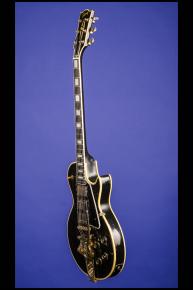A January 1960 (with full '59 specs) Factory Bigsby Les Paul Custom with three PAFs
1960 Gibson Les Paul Custom "Black Beauty" Factory Bigsby.
This January 1960 Les Paul Custom with factory Bigsby weighs just 10.10 lbs. and has a solid mahogany body with a slightly arched top. One-piece mahogany neck with a typical '59 profile, a comfortable nut width of just between 1 5/8 and 1 11/16 inches and a standard Gibson scale length of 24 3/4 inches. Ebony fretboard with 22 original thin frets and inlaid pearl block position markers. The top of the guitar has seven-ply binding, the back of the guitar has five-ply binding, the headstock has five-ply binding, and the fretboard has single white binding. Headstock with inlaid pearl "Gibson" logo and five-piece pearl split-diamond inlay. Two-layer (black on white) truss-rod cover. Individual Grover Roto-Matic tuners with half-moon metal buttons. The serial number "0 0159" is inked in yellow on the back of the headstock. Three original PAF (double-black) humbucking pickups with very strong outputs of 8.34k, 8.70k, and 8.80k. The neck and middle position pickup rings are stamped on the underside "MR 491 / M-69 7" and the bridge pickup ring is stamped on the underside "MR 492 / M-69 8". Five-layer (black over white) plastic pickguard. Four controls (two volume, two tone) on lower treble bout plus three-way selector switch on upper bass bout. Black plastic bell-shaped "Bell" knobs. ABR-1 Tune-O-Matic non-retainer bridge with metal saddles and factory Bigsby vibrato tailpiece. All hardware gold-plated. The potentiometers are all stamped "134 933" (Centralab August 1959). There is some light belt buckle scarring on the back of the guitar (barely down to the wood in a couple of places). There is some natural playing wear to the finish on the top, especially by the bass-side of the end of the fretboard, on the bass-side of the middle pickup and also on the treble edge just by the neck pickup volume control. There are a couple of small surface chips on the edges of the guitar, and some tarnishing to the gold-plated hardware. The first five original thin frets show a little playing wear. That all said, this is a totally original and very early 1960 Custom with full '59 specs. It has that oh so perfect neck and a sound to die for - and is certainly one of the best factory Bigsby examples that we have ever seen. At just over ten pounds It is on the light side for a 'Bigsby' Custom. This amazing guitar in strong excellent plus (8.75) condition. Housed in its original Gibson five-latch black pebble-grain "black beauty" hardshell case with yellow/orange plush lining (8.75).
"In a move designed to widen the market still further for solidbody guitars, Gibson issued two new Les Paul models in 1954, the Custom and the Junior...The two-pickup Custom looked classy with its all-black finish, multiple binding, block-shaped position markers in an ebony fingerboard, and gold-plated hardware, and was indeed more expensive than the gold-top. Paul said that he chose the black colour for the Custom. 'When you're on stage with a black tuxedo and a black guitar, the people can see your hands move with a spotlight on them. They'll see your hands flying.' The Custom had an all-mahogany body, as favoured by Les Paul himself, rather than the maple/mahogany mix of the gold-top, giving the new guitar a rather mellower tone...The Les Paul Custom was promoted in Gibson catalogues as 'the fretless wonder' because of its use of very low, flat fretwire, different to the wire used on other Les Pauls at the time and favoured by some players for the way it helped them play more speedily...The September 1954 pricelist showed the Les Paul Custom at $325 and the Les Paul Junior at $99.50. The gold-top meanwhile had sneaked up to $225" (Tony Bacon, 50 Years of the Gibson Les Paul, p. 25). The Custom was the first Les Paul model to receive the company's Tune-O-Matic bridge, used in conjunction with a separate bar-shaped tailpiece, which offered for the first on Gibsons the opportunity to individually adjust the length of each string, thus improving tuning accuracy.














